


High arches can lead to a number of problems affecting your feet and lower body. High arch insoles support your foot’s natural arch, providing both comfort and support while correcting problems with supination, which happens when your foot and ankle roll outward when walking. The best way to treat and correct a high foot arch is wearing an orthotic insole for high arches. High arches require specialized support compared to normal feet.

If your foot is not healthy, it could cause long-term problems and sometimes disability. While it is a normal part of the body, a high foot arch causes pain and can inhibit your walking and daily activities. Only about 20 percent of people have high arches, making it less common than flat feet or a neutral arch. You can find your arch height by taking an at-home test like the wet test or consulting a podiatrist for a proper diagnosis. Also called a cavus foot, high arched feet have higher than normal arches. The arch of your foot is the space between the ball of your foot and your heel. What Does It Mean When You Have a High Foot Arch? Keep reading to learn more about why you need high arch support and how high arch insoles like PowerStep® Pinnacle High help to improve foot function while preventing and relieving pain. Wearing a proper orthotic shoe insert for high arches can help correct the problem and help you avoid injury or pain. Without proper support for high arches, it can interfere with your posture and cause a variety of foot health issues, including sprained ankles, difficulty walking, and supination. Direct arch support is actually uncomfortable for many people since it inhibits the normal flexing of the foot.A high foot arch height is a common issue that affects your foot function. A supportive insole stabilizes the heel and distributes pressure across the base of the foot, instead of concentrating pressure into the arch area. What is really needed, though, is “foot support” which helps stimulate the arch muscles to be engaged and active. Low or collapsed arches: People who have low or collapsed arches often ask for “arch support” insoles. This reduces foot elongation when weight bearing, creating a better fit and lessening the need to size up when buying footwear. This reduces excess volume in the rear of the shoe and stabilizes the heel of the foot, minimizing the heel slip that can cause hot spots and blisters.įoot elongation: For those with significant foot elongation in one or both feet when measured standing as compared to sitting, a supportive insole can help. Heel slippage: A shoe that fits well in the mid- and forefoot but allows heel slippage or lift may be improved with a supportive, mid- to high-volume insole. Insoles vary in heel and arch dimensions an REI footwear specialist can assess your feet to see which type works best. If you have any of the following common fit problems, insoles may help. Though not customized to an individual foot, support insoles come in different models and profiles to suit most foot shapes or footwear types. Supination or over-pronation: Support insoles moderate a tendency for the feet to either supinate (roll out) or overpronate (excessive rolling in) when walking or running.

Plantar fasciitis: Medical professionals routinely recommend the use of a supportive insole as part of the treatment protocol for this painful condition resulting from tears in the plantar fascia-a band of connective tissue which connects the heel to the forefoot.Structural misalignment, which can manifest not only as foot pain, but discomfort in the ankles, knees, hip, back, neck or head.Supportive insoles are best for the following conditions: This differs from the soft, cushy insoles that you might find at your local drug store. Comfort is derived from the increased stability rather than direct cushioning. They feature a harder material for structural support and stability. The types of insoles you'll find at REI are sometimes called "support" or "sport" insoles.


 0 kommentar(er)
0 kommentar(er)
